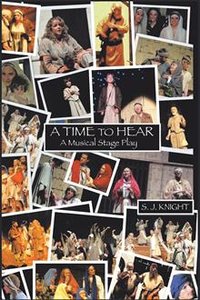Title: A Time to Hear: A Musical Stage Play
Author: S.J. Knight
ISBN: 9781514442142
Publisher: XlibrisAU
Pages: 342
Genre: Fiction / Historical, Musical Drama, Musical Score & Lyrics
Reviewed by: Gadelha Solomon
Buy on AmazonPacific Book Review
Shalom and welcome to the world of S. J. Knight’s musical play titled A Time to Hear, Book One of 4 plays in a related series with the others named: A Time to See (Book Two); A Time to Speak (Book Three); and A Time to Act (Book Four). In A Time to Hear, the author created a period piece musical of biblical proportions. Taking place in a Banayim, Galilee; a small village, the play has a score of characters developed by the imaginative creation of every detail articulated in the various chapters and sections of the book.
The storyline follows the life of the main character, Dan, son of Ammiel, a shepherd, along with other members of their immediate and extended family. Questioning his own religious foundations and beliefs, Dan asks, “Where do my prayers go?” That begins his search for wisdom. Dan hears of a prophet, who comes to Banayim, and seeks his advice, adding a theatrical technique to reflect Dan’s inquisitive thoughts into poignant scripted dialog; with of course songs embellishing his epiphany. Embedded with the layers of religious overtones, themes, origins of truth and a sense of humanity, the story has drama, humor, Biblical references and challenges, resulting in a plot climax in a triumphant ending with jubilations.
No detail of character development, costume, make-up, and personality traits escaped the minutia of details articulated by S. J. Knight’s descriptive and comprehensive descriptions. In A Time to Hear, the book is divided into sections, each bringing to the director producer’s minds the necessary authenticity of creating a period piece of this type. Frankly, I found many of the author’s comments revealing of how our society has changed. For example, if the actor needs to ad-lib a line which may have been forgotten, he or she is not to use any modern expressions such as “Wow, yeah, yep, etc.” as that would instantly ruin the moment. Also, hair needs to be in style with unshaven faces on the men, no artificial colors or trendy cuts. Tattoos need to be covered with make-up or clothing, as these weren’t used in society until 1200 years or so later.
Roughly 100 of the 343 pages are devoted to the musical score, with each of the songs represented both in lyrics and musical layout. In viewing the layout, it appears to be clear to read with musical collisions avoided, thus being able to have a conductor rehearse without frustration. As to the melodies, I asked my wife who is a concert harpist to play a few of the songs, and it was quite enjoyable – nothing like “Fiddler on the Roof,” which is a modern interpretation of older rifts, but the songs had a distinctive Hebrew infliction, harmony and tone. Coupled with the synchronized lyrics, the music is a brilliant creation of chorus and solos which will seem to the audience both new and familiar, while yet original, when hearing it for the first time.
Finally the book reveals photographs of prior productions enabling the reader to see exactly the embodiment of work necessary to create this production. Costume photos for each of the characters, along with clever tips on how to save money in the creation of the outfits, tied together all of the loose ends one would need to consider in putting on this production.
With A Time to Hear having such a flowing deliverable of details, descriptions, music and photographs, one can see how prolific the creativity of S. J. Knight has and the enthusiasm to write about everything which came to mind.



Follow Us